Perth and the Swan Coastal Plain, Western Australia
Overview
Located on the Swan Coastal Plain, Perth is the capital of Western Australia and the state’s most populous city. Perth enjoys a pleasant Mediterranean climate with hot, dry summers and mild, wet winters. While much of the metropolitan area has been cleared for development, a few pockets of remnant bushland have been preserved to protect some of the region’s unique flora and fauna.

Rottnest Island
Located about 20 km off the coast, Rottnest Island is one of the prime holiday destinations near Perth. The island’s white, sandy beaches are popular with tourists and locals alike. Several sheltered bays provide perfect conditions for snorkeling, with numerous colourful corals and fish inhabiting the shallow waters surrounding the island.

Rottnest Island is most famous for its Quokkas (Setonix brachyurus). These small kangaroos were once widespread across south-western Australia, but are now restricted to just a few remote areas and offshore islands as a result of predation from introduced pests. Rottnest Island is one of the last refuges for this iconic species. In fact, the island’s name literally means “rat nest”, a name created by early Dutch explorers who thought that the numerous Quokkas they had encountered on Rottnest Island were large rats.



Fauna
Among the many parrots found in Perth, a spectacular group of rather large and noisy parrots are the Black Cockatoos. One of the two most common species in Perth is the Red-tailed Black Cockatoo (Calyptorhynchus banksii). It is quite large and often seen feeding on the seeds of eucalypts or sheoaks in small groups. The two sexes are readily distinguished by the colour of their tail feathers which are red in males and orange in females.
The other common black Cockatoo in Perth is Carnaby’s Black Cockatoo (Zanda latirostris). It is readily distinguished by its white rather than red or orange tail feathers and is still fairly common despite a decline in population numbers which is attributed to significant habitat loss caused by urban sprawl.
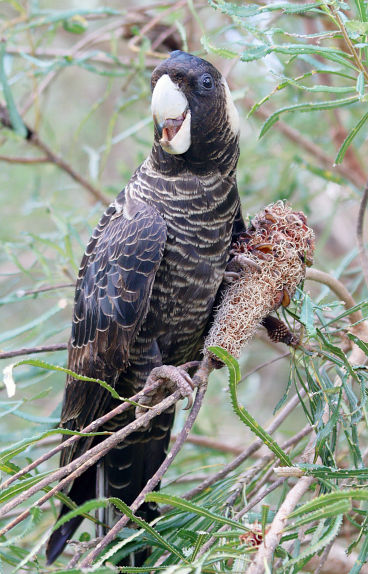

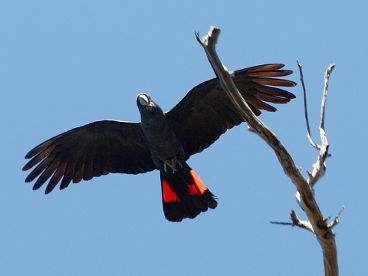
The Galah (Eolophus roseicapilla) is one of several smaller Cockatoo species found in Perth. Galahs are common and widespread across Australia and readily identified by their pink and grey colour. They often congregate in large numbers in grassy areas to feed and can be rather noisy, in particular in the evening before they retire for the night.
Among the two native species of Corella found in south-western Australia, the Little Corella (Cacatua sanguinea) is one of the most commonly encountered parrots in Perth. Little Corellas are rather noisy birds and often congregate in large numbers in parks and along roadsides to feed. They look very similar to the introduced Eastern Long-billed Corella (Cacatua tenuirostris) from which they are distinguished by their shorter bill and mostly white face.
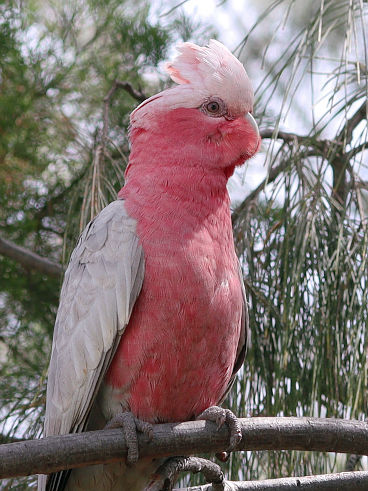
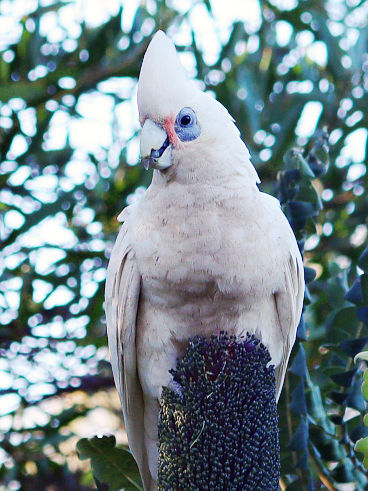
A common Lorikeet found in Perth is the local subspecies of the Australian Ringneck (Barnardius zonarius subsp. semitorquatus). This colourful bird can still be seen in good numbers throughout the metropolitan area, although it is facing fierce competition for nesting trees from the introduced Rainbow Lorikeet.
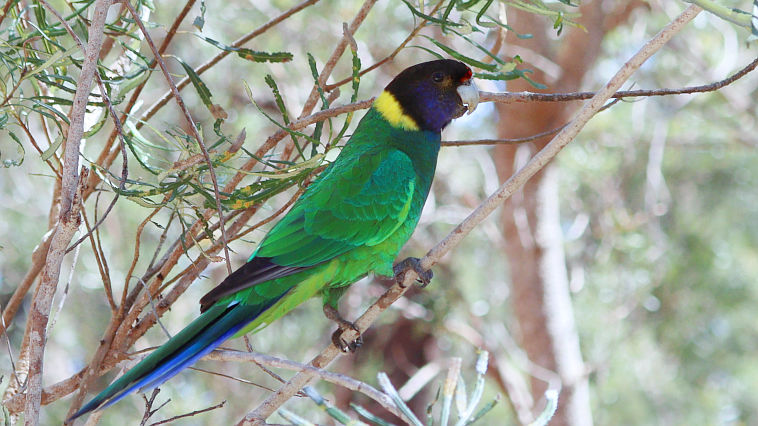
The Rainbow Lorikeet (Trichoglossus haematodus) is undoubtedly the most colourful parrot encountered in Perth. Originally from eastern Australia, Rainbow Lorikeets were introduced to Western Australia in the 1960s and are now a common and widespread pest in the Perth area. As with many parrots, they are rather noisy and often assemble in small groups to feed on seeds and fruits during the day.

Other iconic birds that are common in the Perth area include the Laughing Kookaburra (Dacelo novaeguineae) and the Australian Magpie (Gymnorhina tibicen). The Laughing Kookaburra is one of the largest species of Kingfisher in the world and famous for its loud call reminiscent of laughter. Native to eastern Australia, it was deliberately introduced to WA in the late 19ᵗʰ and early 20ᵗʰ century. Today, the Laughing Kookaburra is common and widespread across south-western WA.
Being common and widespread throughout most of Australia, the Australian Magpie is one of the most intelligent birds and well-known for its complex, melodic calls. Magpies are even capable of mimicking the calls of other birds. Being fairly large in size, they are also feared for their habit of fiercely defending their nest during the breeding season.


Listen to the call of the Australian Magpie:
Among the largest and most spectacular birds found in Perth is the Australian Pelican (Pelecanus conspicillatus). With a wingspan of up to 2.5 m and one of the longest bills of any bird, it is an impressive sight and still commonly encountered at beaches and estuaries across the city. Despite their enormous size and weight, Australian Pelicans are excellent flyers, and it is not uncommon to find them perched on streetlights high above the ground.
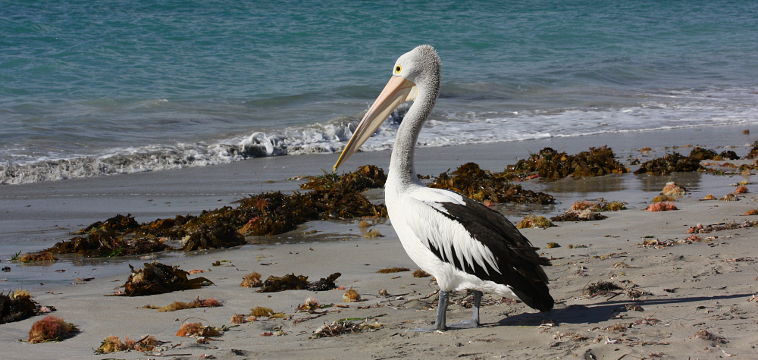
Another common waterbird found in Perth is the Australasian Darter (Anhinga novaehollandiae) which can be encountered along the shores of lakes and rivers such as the Swan River. The Australasian Darter feeds mainly on fish and is often seen perched on logs or rocks to dry its wings in the sun.
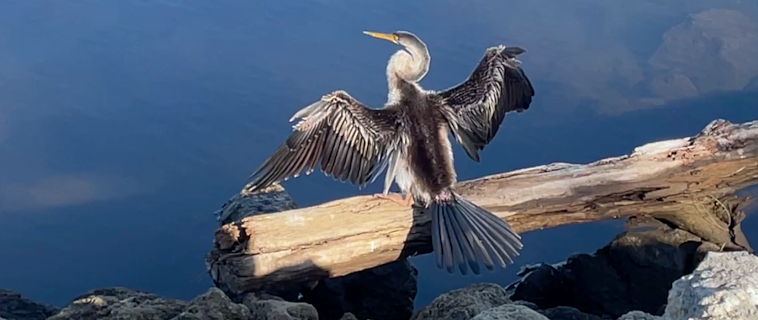
The most iconic among the many reptiles in the Perth area is undoubtedly the Bobtail Lizard (Tiliqua rugosa), also known as the Shingleback. This curiously looking creature is abundant in bushland in and around Perth and is often seen basking in the sun during the day. When they feel threatened, Bobtail Lizards will open their mouth widely to reveal their blue tongue which apparently helps to scare away predators.
Another iconic lizard found in Perth is the Western Bearded Dragon (Pogona minor), which is one of the most docile reptiles. Instead of fleeing, it relies entirely on its camouflage and remains motionless when being approached. Bearded Dragons usually display their spiny beard only as part of their mating ritual or to fend off rivals.

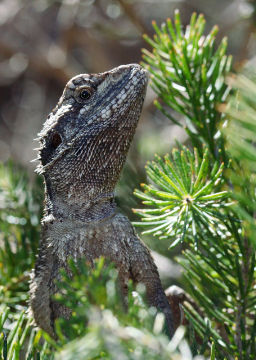

Numerous other reptile species are commonly encountered across the Perth metropolitan area, in particular several different species of Skink such as the tiny Buchanan’s Snake-eyed Skink (Cryptoblepharus buchananii) with its characteristic, large eyes. Due to their secluded lifestyle, snakes are rarely encountered, although species such as the Carpet Python (Morelia spilota) or the highly venomous Tiger Snake (Notechis scutatus) are generally common and widespread.
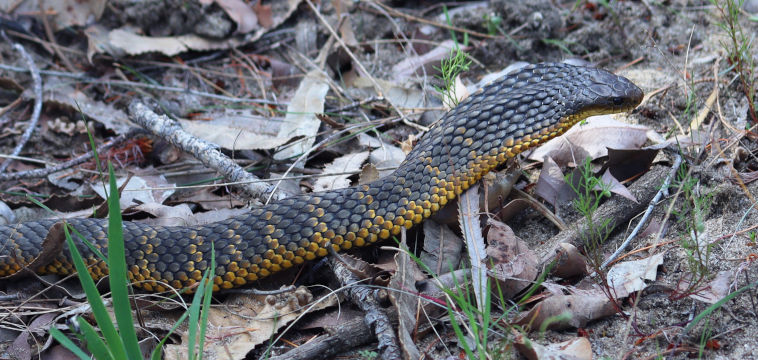
Butterflies
While there are generally very few butterflies in Western Australia, Perth is blessed with a surprisingly large variety of species. What’s more, a significant number of Perth’s butterfly species is endemic to south-western Australia and found nowhere else in the world. Among the more commonly encountered butterflies are several species of Blue and Hairstreak (Lycaenidae), including the beautiful Long-tailed Pea Blue (Lampides boeticus) which is a regular visitor to suburban parks and gardens. Incidentally, this magnificent species is one of the world’s most common and widespread butterflies and can be found on all continents except America and Antarctica.

Other Blues are restricted to remnant bushland in and around Perth, including the Blotched Dusky Blue (Candalides acasta), the spectacular but uncommon Copper Dusky Blue (Candalides cyprotus) and the Rayed Blue (Candalides heathi). All three species are widespread throughout the temperate regions of Australia and display spectacular iridescent colours on the upperside of their wings. Another common species of native bushland is the Western Australian subspecies of the Fringed Heath Blue (Neolucia agricola subsp. occidens).




A real treasure of remnant native bushland in Perth is the Turquoise Jewel (Hypochrysops halyaetus). This spectacular butterfly is endemic to Western Australia, and Perth marks the southern limit of its geographic range. Turquoise Jewels display spectacular iridescent colours on the upperside of the wings, while the bright orange underside is covered in a characteristic pattern of iridescent silvery patches.



Another species endemic to Western Australia is the Varied Hairstreak (Jalmenus inous) which is often found in large numbers in coastal areas where the caterpillars feed on different Acacia species. While the underside looks relatively inconspicuous, the iridescent blue suffusion on the upperside of the wings creates a spectacular display, in particular on sunny days.



Another common butterfly of the Perth area is the Western Xenica (Geitoneura minyas). It too is endemic to south-western Australia and abundant in native forests and woodland. The Western Xenica is closely related and remarkably similar to the Marbled Xenica (Geitoneura klugii) which is common and widespread across southern Australia. In the Perth area, both species are often found flying together at the same time of the year, making identification challenging. Fortunately, there is an easy way to tell the two species apart: the Western Xenica has black eyes while the eyes of the Marbled Xenica are grey-brown.




Several characteristic species of Skipper (Hesperiidae) are found in Perth, including the widespread White-banded Grass Dart (Taractrocera papyria). While this species is also found in south-eastern Australia, the Western Australian populations belong to a different subspecies, agraulia. Two more species encountered in remnant Banksia woodland across Perth include the Blue Iris Skipper (Mesodina cyanophracta) and the Western Brown Skipper (Motasingha dirphia). Both are endemic to south-western Australia and are on the wing in late spring.



Another rather handsome Skipper endemic to Western Australia is the Silver-spotted Ochre (Trapezites argenteoornatus) which is found along the west coast of WA and is common in coastal heathland around Perth during the spring. In contrast, the equally abundant Wedge Grass Skipper (Anisynta sphenosema) is one of very few butterfly species of Perth that are active during autumn rather than spring. It is a common visitor to suburban gardens and is another one of Western Australia’s endemic species, underlining the high degree of endemism that makes south-western Australia one of the world’s prime biodiversity hotspots.


In addition to the significant number of endemic species, several of Australia’s most common and widespread butterflies can be found in Perth as well, including well-known species such as the Yellow Admiral (Vanessa itea) and one of Australia’s most abundant species, the Australian Painted Lady (Vanessa kershawi), which is widespread throughout temperate and subtropical Australia.
Another widespread species is the aptly-named Common Brown (Heteronympha merope) which is super-abundant across most of temperate Australia, including Tasmania. Curiously, male and female Common Browns look entirely different and could easily be mistaken for two separate species. They are also typically encountered at different times of the year, with males more abundant during late spring and early summer, while females are more frequently seen during summer and early autumn. The Western Australian populations form a separate subspecies, duboulayi, which differs slightly from the nominate subspecies found across south-eastern Australia.
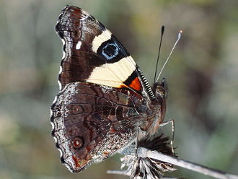
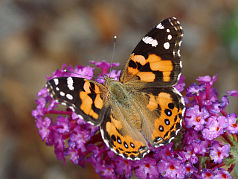
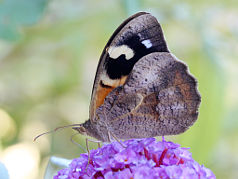
Orchids
The numerous parks and bushland areas in and around Perth are a paradise for native orchids. Among the most recognisable orchids are the aptly named Donkey Orchids (Diuris) with their characteristic “donkey ears” formed by the two petals. By far the most common species found in Perth is the Pansy Orchid (Diuris magnifica) which can be found in large numbers in remnant bushland across the metropolitan area. Their beautiful yellow and purple flowers are a delight to see during late winter and early spring, often forming large colonies of sometimes hundreds of individual plants.
Although not quite as abundant as the Pansy Orchid, several other Donkey Orchids can be found across the Swan Coastal Plain, including the early-flowering Winter Donkey Orchid (Diuris brumalis) which can be seen in July and August. A similar-looking species, the Small-flowered Donkey Orchid (Diuris porrifolia), flowers slightly later, but is equally uncommon on the coastal plain and much more abundant along the Darling Scarp. Unfortunately, many of the Donkey Orchids are notoriously difficult to identify, as they all look rather similar, and even experts appear to be struggling to identify certain specimens or even agree on how many species there are in total.





Among the most spectacular orchids of Perth and the Swan Coastal Plain are the Spider Orchids (Caladenia). A characteristic species of native bushland across the Perth metropolitan area is the Dancing Bee Orchid (Caladenia discoidea) with its magnificent green and red flowers. Despite its unique appearance, the Dancing Bee Orchid is easily overlooked as its flowers perfectly blend in with the surrounding vegetation. Another relatively common species found in remnant bushland across Perth is the White Spider Orchid (Caladenia longicauda) with its long, almost purely white petals and sepals. White Spider Orchids are common and widespread across all of south-western Australia and often form hybrids with other species of Spider Orchid.


One of the most beautiful Spider Orchids of Perth is undoubtedly the Carousel Spider Orchid (Caladenia arenicola). This magnificent species is still reasonably common in remnant bushland throughout the Perth area and comes in a variety of different colours. The Carousel Spider Orchid often hybridises with other Spider Orchids, including the White Spider Orchid (Caladenia longicauda) and the very similar Tuart Spider Orchid (Caladenia georgei), making identification of individual specimens difficult in some cases.


Another relatively common species of Spider Orchid is the Swamp Spider Orchid (Caladenia paludosa) which, as its name suggests, is restricted to swampy areas. While superficially similar to the Carousel Spider Orchid, it is readily distinguished by its characteristic anvil-shaped labellum fringe segments and the fact that its petals aren’t clubbed and are pointing upwards rather than downwards. It is known to hybridise with the Carousel Spider Orchid in places where both species grow together.
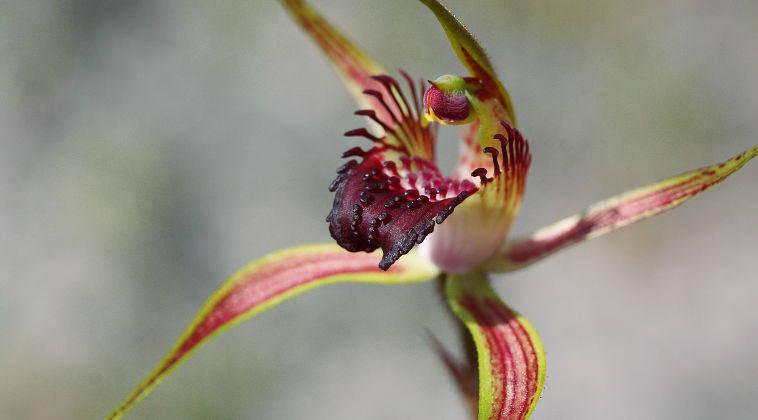
One of the rarest and most endangered Spider Orchid found on the Swan Coastal Plain is the Grand Spider Orchid (Caladenia huegelii). Once fairly common and widespread, most of its former habitat has been destroyed by urban development. It is now restricted to just a few small populations scattered across the coastal plain between Perth and Bunbury where it grows in sandy soils in mixed Banksia and Eucalyptus woodland.
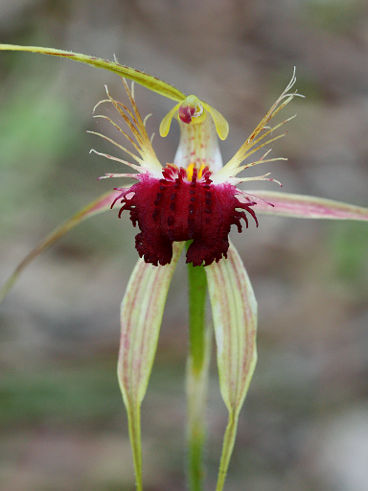
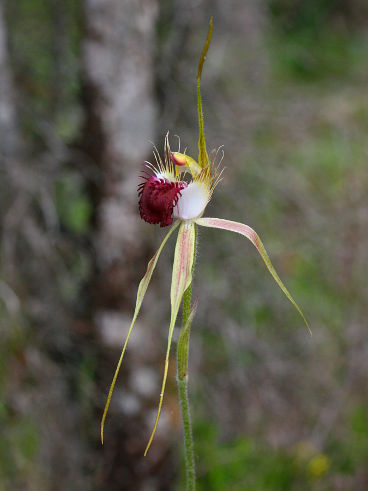
Another rare and restricted orchid is the Island Point Spider Orchid (Caladenia swartsiorum). Like the Grand Spider Orchid, it is endemic to the Swan Coastal Plain where it is found in small, isolated populations between Mandurah and Bunbury, growing in between sedges in winter-wet areas. While looking similar to the White Spider Orchid (Caladenia longicauda), it is easily distinguished by its pale-yellow rather than white flowers.
The tiny Zebra Orchid (Caladenia cairnsiana) is common and widespread across south-western Australia, but is uncommon on the Swan Coastal Plain where it can be found in forests and winter-wet areas. Due to its small size it is excruciatingly difficult to find.
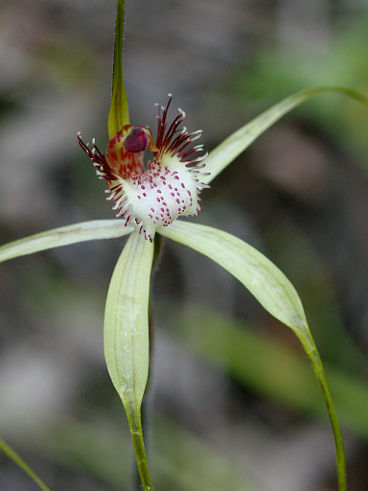

Several other species of Spider Orchid occur across the Swan Coastal Plain, but are not frequently encountered. Although generally common and widespread, the Leaping Spider Orchid (Caladenia macrostylis) is rarely seen, which is partly due to its small size and rather dull colouration. Another rather small and inconspicuous species is the Yellow Spider Orchid (Caladenia denticulata) which prefers moist habitats such as forests and winter-wet flats and, despite its common name, can be either pale-yellow or dark-red.



Two of the most abundant orchids of Perth are the Cowslip Orchid (Caladenia flava) and the Pink Fairy Orchid (Caladenia latifolia). Both are very common and widespread in native bushland and often form large clonal colonies. The Cowslip Orchid can be found in a variety of different habitats, while the Pink Fairy Orchid mainly occurs in forests and woodland where it usually forms small colonies underneath trees. Where they co-occur, the two species occasionally form a spectacular hybrid, the aptly-named Spectacular Spider Orchid (Caladenia × spectabilis), which by far outshines its two parents.

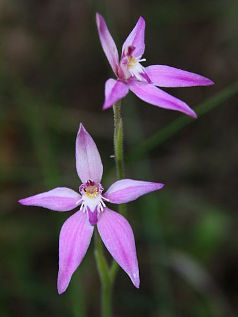
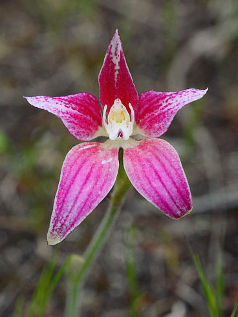
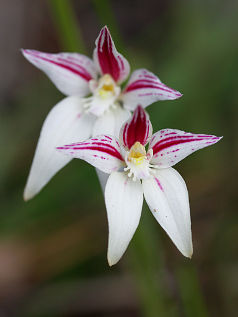
As their name suggests, Greenhood Orchids (Pterostylis) are almost entirely green and for that reason easily overlooked as they perfectly blend in with the surrounding vegetation. The two most common species in the Perth area are the Coastal Banded Greenhood (Pterostylis orbiculata) and the uniquely shaped Jug Orchid (Pterostylis recurva). Both can be found in large numbers in native forest and woodland throughout the city and adjacent coastal plain.
A rare and only recently discovered species is the peculiar Tuart Rufous Greenhood (Pterostylis frenchii) which grows in near-coastal forests and woodlands south of Mandurah. It is the only Rufous Greenhood known to occur on the Swan Coastal Plain, whereas all other Western Australian species are found much further east in the more arid inland areas of the state. Due to its small size and pale-green colour, the Tuart Rufous Greenhood is excruciatingly difficult to find and for that reason had evaded discovery until the 1990s.
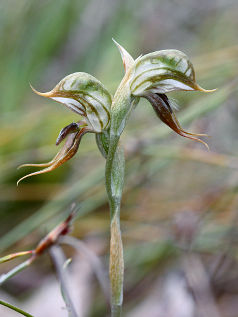
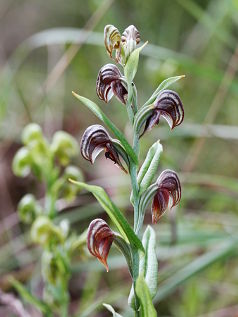
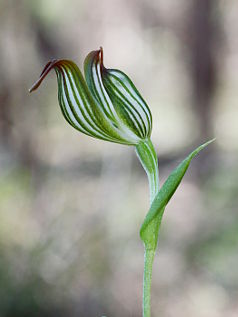
The spectacular Rattle Beaks (Lyperanthus serratus) is common across the higher-rainfall areas in the south-western corner of the state, with Perth being at the northern limit of their geographic range. Yet this magnificent orchid can still be found in good numbers in some of the remnant native bushland reserves across the city. Probably the most abundant of all orchids in Perth is the Common Mignonette Orchid (Microtis media). This inconspicuous species can be found almost anywhere in large numbers, including suburban gardens and parks, flowerbeds, and even roadsides and car parks.


Among the most magnificent orchids found on the Swan Coastal Plain are the Sun Orchids (Thelymitra). Unlike other orchids, Sun Orchids are able to close their flowers, and most species will only open up on sunny and warm days and remain closed otherwise. Many of the species found around Perth have blue flowers and can be difficult to tell apart. The bluest of them all is the Queen Orchid (Thelymitra crinita), which is easily identified by its bright-blue flowers and characteristic fluffy column with purple tufts. It is generally common and widespread across south-western Australia and grows in forests and woodland.
Two other blue-flowered species that are commonly encountered around Perth are the Scented Sun Orchid (Thelymitra macrophylla) and the Shy Sun Orchid (Thelymitra graminea). Both look rather similar and are most easily distinguished by the size of their leaves.
Another common and widespread species is the Lemon-scented Sun Orchid (Thelymitra crinita), also known as the Vanilla Orchid. It prefers moist habitats such as granite outcrops, winter-wet flats and the edges of seasonal creeks and is easily identified by its yellow flowers with characteristic brown column wings.
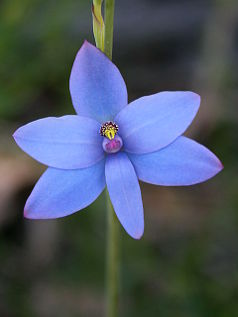
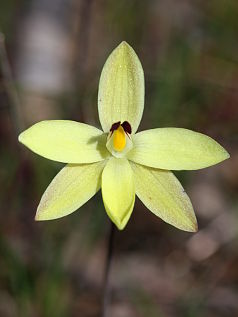
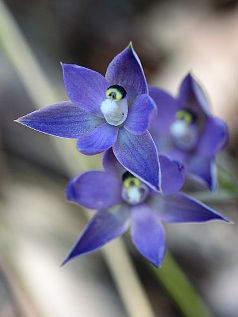
Among the most handsome Sun Orchid of Perth is the Leopard Orchid (Thelymitra benthamiana) which owes its name to the numerous dark blotches that cover its greenish-yellow flowers. The Leopard Orchid is rarely seen despite the fact that it is actually quite common and often forms large colonies in forests and woodlands. This can be attributed to its rather late flowering period (October–November) well after the peak of the annual wildflower season and the fact that the orchids are fairly modest in size and almost perfectly camouflaged in their shady woodland habitat.
A less common species is the magnificent Chestnut Sun Orchid (Thelymitra fuscolutea) which looks somewhat similar to the Leopard Orchid, but is readily identified by its ochre-coloured flowers and characteristic cream-white column with fringed wings. While rare on the Swan Coastal Plain near Perth, it is still relatively common along Western Australia’s south coast between Albany and Augusta.
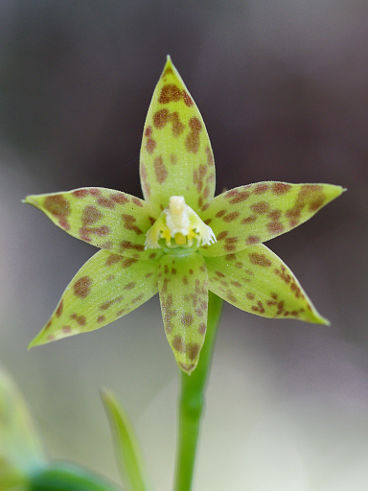

Wildflowers
Each year, in late winter and early spring, large numbers of colourful wildflowers emerge across Perth following the winter rain. Among the most famous and spectacular of these are the Banksias which are closely related to the Proteas found in South Africa. Many species are notable for their large and colourful flower spikes that are pollinated by birds rather than insects. They are an important source of food for several nectar-feeding bird species such as the New Holland Honeyeater (Phylidonyris novaehollandiae) or the Red Wattlebird (Anthochaera carunculata).
The Firewood Banksia (Banksia menziesii) flowers in autumn and winter and is easily recognised by its large, red and yellow flowers which are a spectacular sight. The Slender Banksia (Banksia attenuata) flowers during late spring and early summer and features slender, bright-yellow flower spikes that can be seen from a long distance away. The largest and most spectacular species is the Bull Banksia (Banksia grandis), which flowers during spring and is identified by its very large, greenish-yellow flower spikes, long, deeply serrated leaves and huge seed cones. All three species are common and widespread in the Perth area and often form mixed Banksia woodlands in the sandy soils of the Swan Coastal Plain.
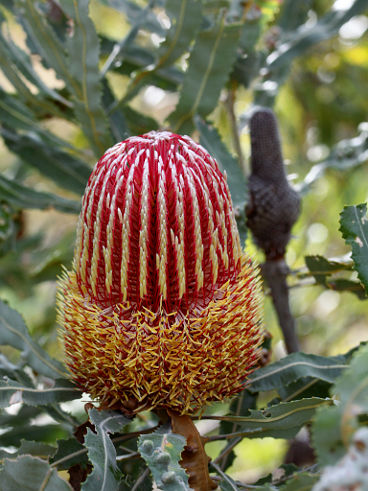
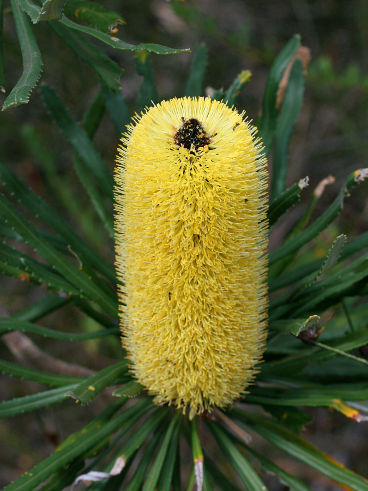
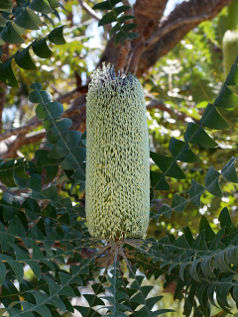
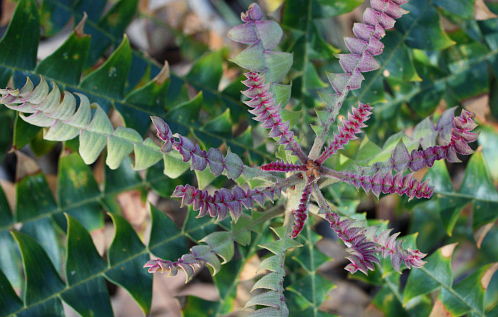
Fringe Lilies (Thysanotus) are among the most handsome and easily recognisable wildflowers in the Perth area. They are generally common in remnant bushland, with many species flowering in late spring and early summer. Several different species occur on the Swan Coastal Plain, but unfortunately they can be difficult to tell apart, as their purple flowers look rather similar, as is illustrated by the three different species depicted below. However, differences in habit, leaf morphology and in the number and size of the stamens will normally allow identification of most species.


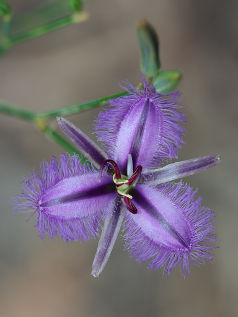
A small selection of some of the most colourful wildflowers of the Swan Coastal Plain is shown below. Not all of Perth’s wildflowers are native, though, as many exotic species have been accidentally introduced into the wild, usually as garden escapes originating from South Africa.

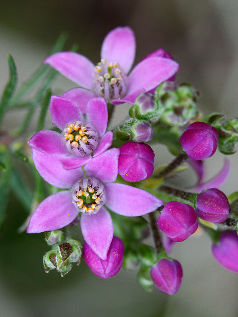



While wildflowers can be found all year round, the peak flowering season lasts roughly from August until October, with very few species in flower during the summer and autumn. This is the result of Perth’s Mediterranean climate with cool, wet winters and hot, dry summers. A small selection of the wide range of different shapes and colours of Perth’s winter and spring flowers is illustrated below.
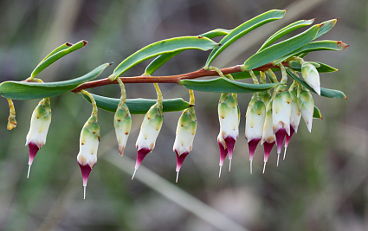
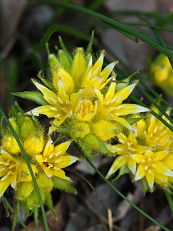
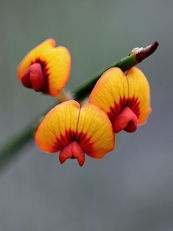
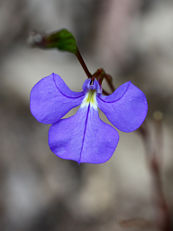
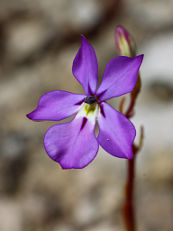
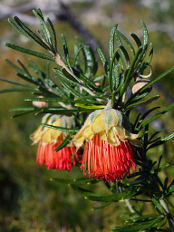
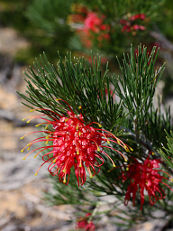
Among Perth’s most unique and spectacular wildflowers are the Kangaroo Paws, most notably the Cat’s Paw (Anigozanthos humilis) and the Red-and-green Kangaroo Paw (Anigozanthos manglesii). The latter is also known as Mangles’ Kangaroo Paw and is the official state flower of Western Australia. Both species grow in well-drained, sandy soils and are abundant in native woodland during late winter and spring.


Another rather intriguing group of plants found on the Swan Coastal Plain are the Triggerplants (Stylidium). As their name indicates, they possess a trigger mechanism that springs into action when an insect lands on the flower and actively deposits the pollen on the insect’s back. Several different species of Triggerplant can be seen around Perth, among which the Coastal Plain Triggerplant (Stylidium neurophyllum), Cow Kicks (Stylidium schoenoides) and Matted Triggerplant (Stylidium repens) are the most commonly encountered ones.
A rather unusual species is the Book Triggerplant (Stylidium sp.), as it is capable of closing its flowers during the night and reopening them on warm, sunny days. Triggerplants are also interesting due to their possible (proto-)carnivory. Several species possess sticky glands along their stems that are believed to be used to trap and digest small insects.
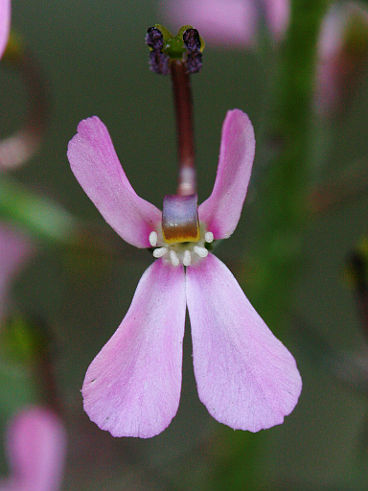
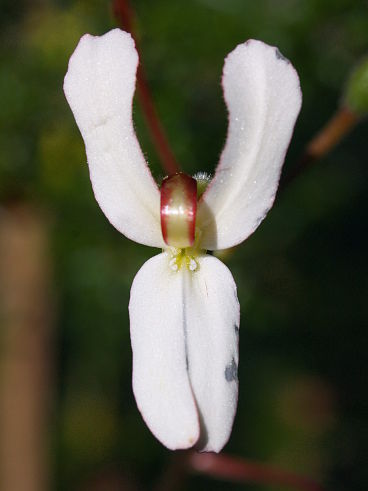
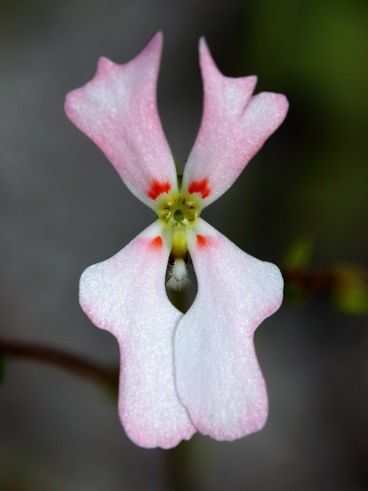
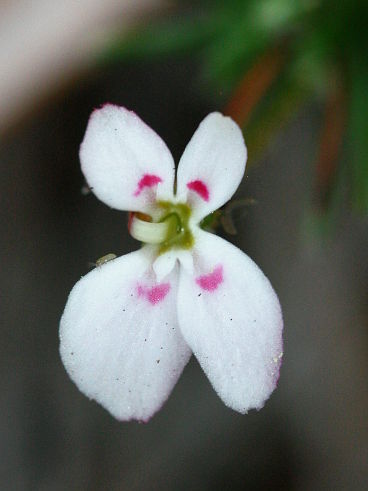
Other Insects
Among the insects of the Swan Coastal Plain, the grasshoppers are particularly abundant and well represented with a large number of species, many of which may not even have been scientifically described yet. One of the largest and most common species is the Giant Green Slantface (Acrida conica). It is characterised by its strangely elongated head, and despite its common name is often brown rather than green.
Many of the grasshopper species on the Swan Coastal Plain are wingless and come in various shades of grey or brown. A small selection of mostly unidentified species is shown below. As a result of their dull colouration they are perfectly camouflaged in the leaf litter and are almost impossible to find unless they are accidentally disturbed. Among these are several similar-looking species of Matchstick Grasshopper of the family Eumastacidae. These tiny grasshoppers are masters of camouflage and easily identified by their strangely elongated head.
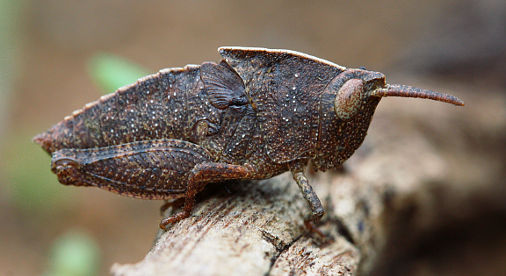
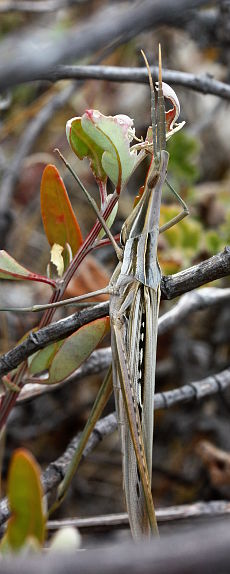
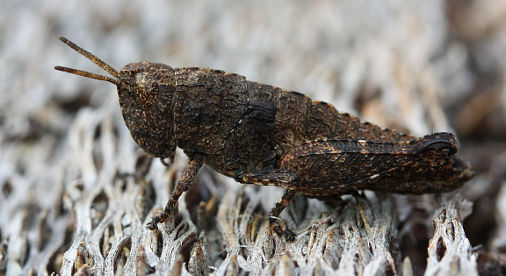
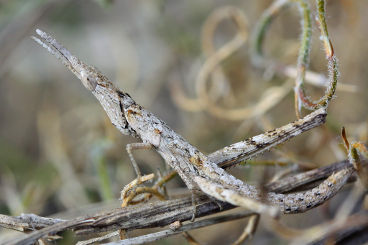
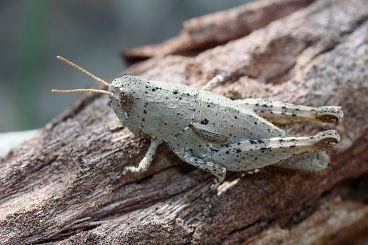
Related to grasshoppers and somewhat similar in appearance are the katydids (fam. Tettigoniidae), also known as bush crickets. They are easily distinguished from grasshoppers by their long and thin antennae which often exceed the length of their body, while all grasshoppers exhibit short and thick antennae instead. Like grasshoppers, katydids are common in the Perth area, and species such as the Common Marauding Katydid (Metaballus frontalis) are frequently encountered in suburban bushland. Due to their generally green or brown colour, many katydids are quite well camouflaged and easily overlooked. An example is the nymph of Andrea’s Balloon-winged Katydid (Tympanophora andreae) which, when huddled against a green leaf or flower stalk, is almost invisible.
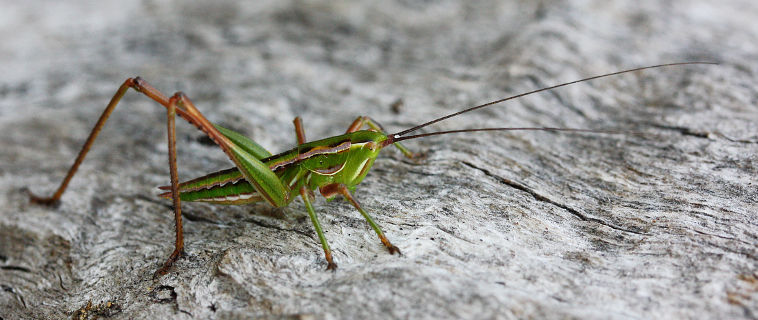
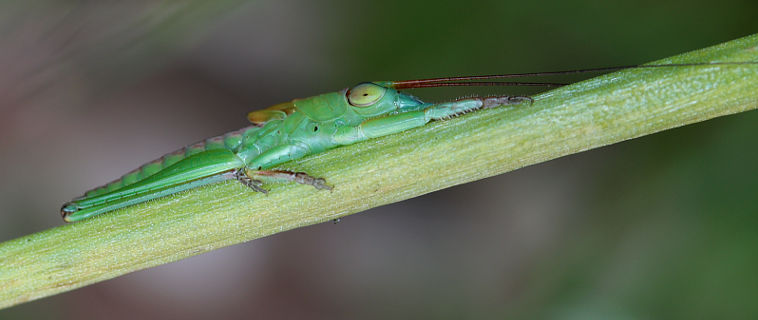
Another characteristic group of insects found in Perth are the mantids (fam. Mantidae). They are entirely unrelated to grasshoppers or katydids even though they might appear superficially similar. Unlike grasshoppers, which feed on plants, mantids are carnivorous and feed on a variety of insects and other arthropods. Most species are ambush predators that wait for their prey to come within reach of their enlarged front legs. One of the most frequently encountered species is the Garden Mantis (Orthodera ministralis), which is a regular visitor to suburban gardens. Due to their green colour, Garden Mantises are well camouflaged and difficult to find despite being fairly common. The same is true for the many other mantid species found in Perth, which are typically green or brown in colour, including the giant Mallee Grass Mantis (Archimantis sobrina) which can grow up to 15 cm long.
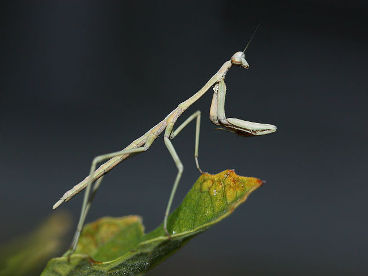

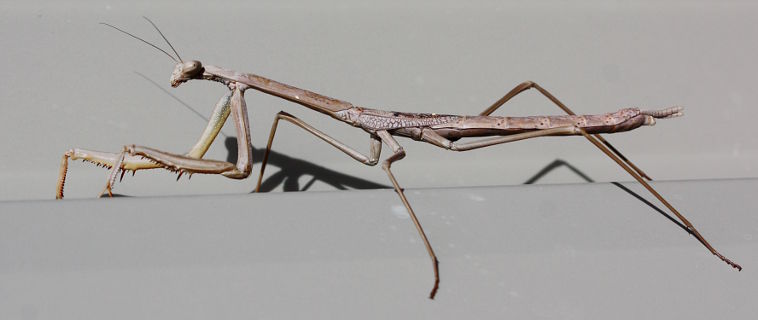
Although normally associated with tropical rainforests, stick insects can also be found in the temperate regions of southern Australia. Among the more common species encountered in Perth is Key’s Stick Insect (Podacanthus keyi) which lives in Eucalyptus trees where it is almost perfectly camouflaged and for that reason extremely difficult to find. When fully mature, Key’s Stick Insect can grow to more than 10 cm in length, although the one shown below is still a juvenile.

Beetles, too, are generally common and widespread, in particular during springtime. The most commonly encountered beetles are the weevils, which is unsurprising given that they make up a significant fraction of all beetle species. Most weevils are readily distinguished from other beetles by their characteristic, elongated snout. While many of them are tiny and difficult to see without magnification, the Swan Coastal Plain is home to several larger and more spectacular species such as the rather unique Spiny Weevil (Catasarcus sp.).
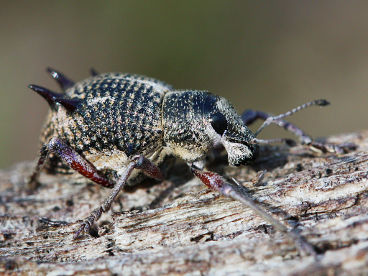
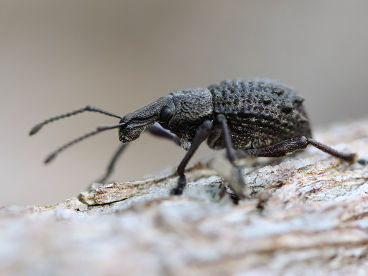
Another common group of insects are dragonflies and damselflies. They are generally found in large numbers in the vicinity of lakes and swamps, but also in forests, woodlands and even suburban gardens in Perth. Among the most frequently encountered damselflies are several species of Ringtail (Austrolestes), including the common Slender Ringtail (Austrolestes analis) and the Blue Ringtail (Austrolestes annulosus). They are commonly seen in suburban areas and all look rather similar, making identification difficult.
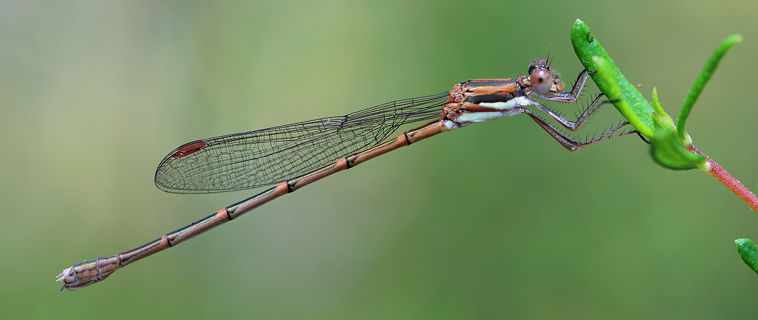
One of the most handsome species of dragonfly is the Blue Skimmer (Orthetrum caledonicum) with its characteristic gold, black and blue colouration. It can be found all across Australia and is common on the Swan Coastal Plain. The males are easily identified by their greyish-blue colour, while the females are of golden colour. Another common species found in the vicinity of water is the Scarlet Percher (Diplacodes haematodes). The spectacular males are uniformly bright-red, while the females have a more subdued brownish colour.
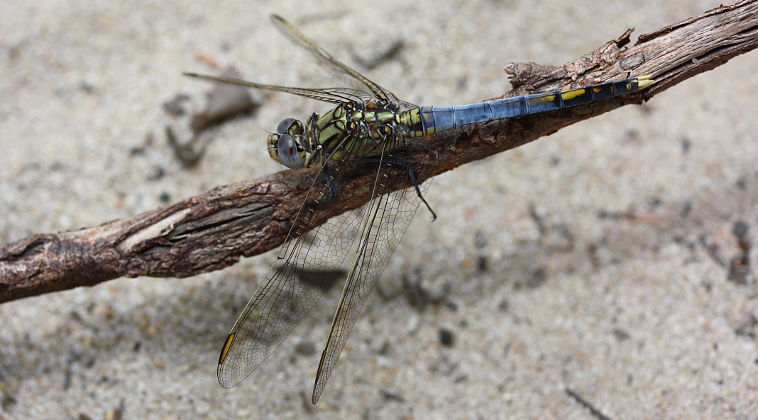
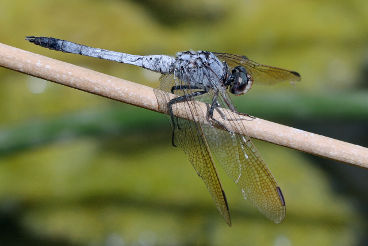

Arachnids
Spiders are generally common in the Perth area and can be found in a wide variety of habitats, including suburban gardens and parks. Among the largest and most spectacular species is the Golden Orb Weaver (Nephila edulis) which builds large, gold-coloured webs that are so strong that occasionally even small birds will get entangled in them. Only female Golden Orb Weavers are large with a body size of up to 4 cm, whereas the tiny males are typically just a few millimetres long and thus rarely noticed.
Another large and colourful spider is the Banded Orb Weaver (Argiope trifasciata) which also builds large and strong webs. The females are immediately recognisable by their large size and characteristically banded body and legs, while the males are tiny and mostly brown. The Banded Orb Weaver is a cosmopolitan species that occurs worldwide. It looks very similar to the Wasp Spider (Argiope bruennichi) which can be found across central and southern Europe.
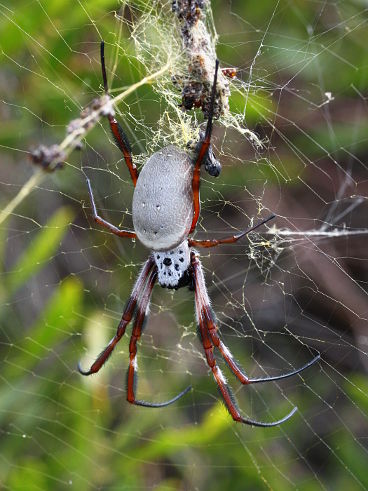
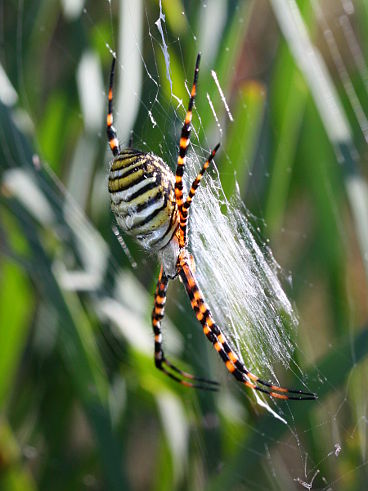
Among Perth’s most common spiders are the tiny Jumping Spiders (fam. Salticidae). They are found almost anywhere in large numbers, including houses and gardens, and are known for their ability to jump, which – in combination with their superb eyesight – allows them to actively hunt for prey. Because of their small size and dull colouration they are easily overlooked, but a few species, such as the Common Peacock Spider (Maratus pavonis), are extremely colourful and also famous for their spectacular mating dance.
Another well-known family of spiders are the Wolf Spiders (fam. Lycosidae) which are commonly encountered in suburban areas. They look relatively dull and usually sit near the entrance of their burrow, waiting for prey to come within striking distance. Wolf Spiders have relatively good eyesight and are easily identified by their two large eyes with a characteristic row of four smaller eyes beneath.
One of the most unusual and colourful spiders found in Perth is the Jewel Spider (Austracantha minax) which is also known as the Christmas Spider due to its abundance during the southern summer. These tiny spiders are commonly found in remnant bushland and are decorated with several rather bizarre-looking spikes which makes them unmistakable. The Jewel Spider is not restricted to Perth, but found across most of mainland Australia as well as Tasmania.
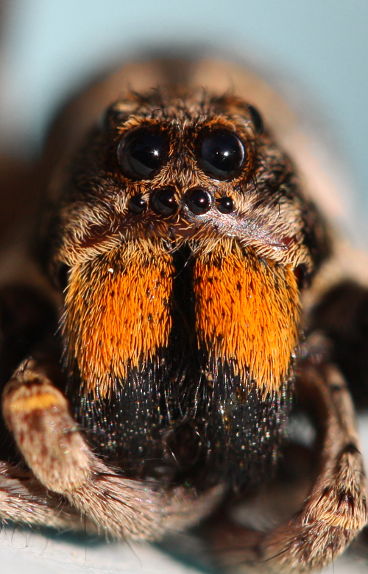
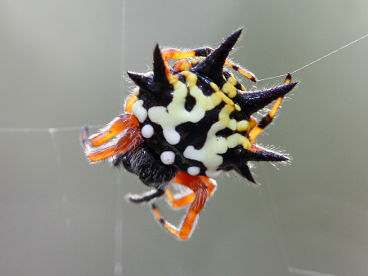
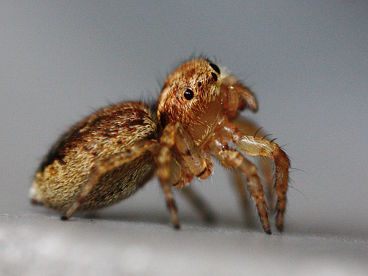
The Marbled Scorpion (Lychas marmoreus) is one of the most commonly encountered scorpions across southern Australia, as it inhabits suburban bushland and occasionally ventures into buildings at night. As with all scorpions, it is strictly nocturnal and will spend the day hiding beneath rocks or tree trunks. Marbled Scorpions are relatively small, and their sting, while painful, is not considered dangerous.
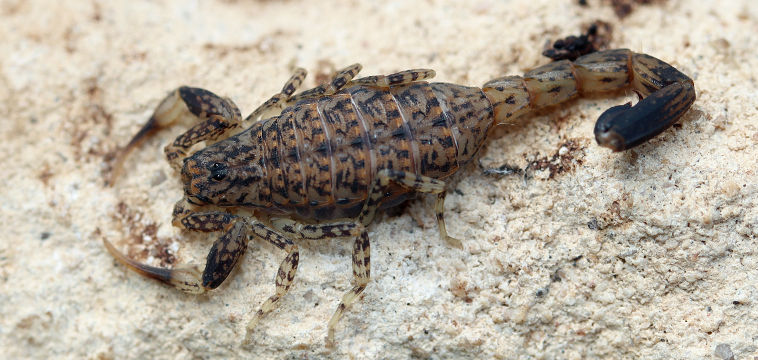
Statistics
List of Butterflies
List of butterfly species that I have encountered in and around Perth so far:
- Papilio demoleus
- Delias aganippe
- Pieris rapae
- Hypochrysops halyaetus*
- Ogyris amaryllis subsp. meridionalis
- Jalmenus inous*
- Candalides cyprotus
- Candalides acasta
- Candalides heathi
- Nacaduba biocellata
- Neolucia agricola subsp. occidens*
- Theclinesthes miskini
- Theclinesthes serpentata
- Lampides boeticus
- Zizina labradus
- Junonia villida
- Vanessa kershawi
- Vanessa itea
- Danaus chrysippus
- Danaus plexippus
- Geitoneura klugii
- Geitoneura minyas*
- Heteronympha merope subsp. duboulayi*
- Trapezites argenteoornatus*
- Motasingha dirphia*
- Anisynta sphenosema*
- Hesperilla donnysa subsp. albina*
- Croitana croites*
- Mesodina cyanophracta*
- Taractrocera papyria subsp. agraulia*
- Cephrenes augiades
* species or subspecies endemic to Western Australia